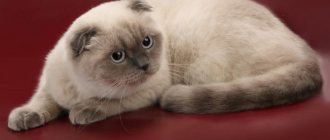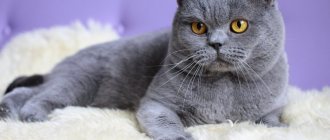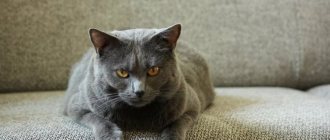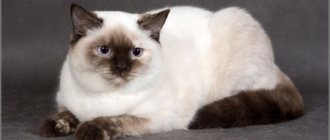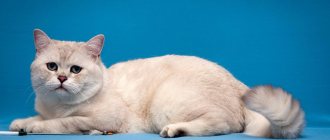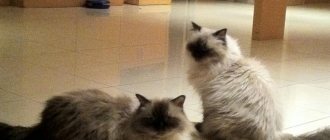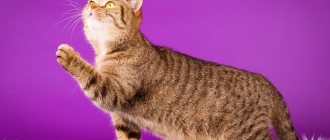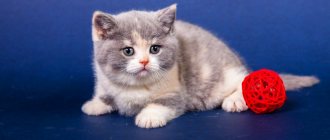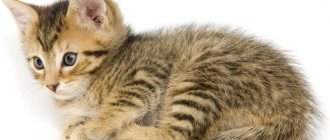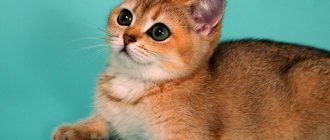The color-point phenomenon
As a result of a mutation in the gene (Color), which is responsible for color, different intensities of coloring of different parts of the body arise. The coloring is most intense on remote (and therefore colder) areas of the body, such as the muzzle, ears, paws and tail, and on the rest of the body surface, where the temperature is higher, practically no pigment is formed. It doesn't disappear completely, but it does lighten to almost white.
Accumulations of pigment in remote areas of a cat's body are called points, translated as a dot or mark. And the color of cats, with intensely colored points in relation to the main body, is called color point, or colored markings.
British Color Point Chocolate
The gene responsible for the Siamese color (cs) is recessive. In order for it to manifest itself, each of the parents must have it: either be color-pointed or be a carrier of this gene in their ancestors. In addition, this gene is linked to blue eye color.
Briefly about the British breed
The British cat breed is considered one of the most ancient; the first mentions of domesticated cats and their images, visually reminiscent of modern Britons, are found in handwritten books of the 7th-8th centuries. However, the breed was officially recognized only at the end of the last century.
British cats became especially popular in the 19th century
Cats of the British breed are distinguished by a large, massive and slightly squat physique . The average weight of males is usually about 7–8 kg, but sometimes individual individuals can reach 10 kg. Females are rarely heavier than 6 kg; they are considerably smaller and more graceful. The British have a muscular, stocky, harmoniously sculpted body with a wide sternum, a massive shoulder girdle and back, as well as strong, thick, slightly short legs. The forehead-shaped, round head with large eyes and wide-set ears is firmly set on a short but strongly developed neck. The chin is well defined, the nose is short and quite wide, and the whiskers are clearly visible on the voluminous cheeks. The tail is of medium length, proportional to the entire body of the animal, thick at the base, tapering towards a rounded tip.
British cats have a massive and strong build.
A purebred Briton is always distinguished by a short and very thick soft coat that does not lie close to the body, plush to the touch, with a densely packed, high-quality undercoat.
What does Blue Point color mean?
Bluepoint color is one of the varieties of color point color, which appeared as a result of the deliberate introduction of Siamese and Thai cats into the British breed. The goal of the breeders was to obtain Britons with an uncharacteristic Siamese or Himalayan (as it is called in America) coloring.
Color standards
The main background of the coat of the British Bluepoint is as close as possible to pure white cool color or has a slight gray-bluish tint. The muzzle, paws, tail and ears are painted in contrasting blue. All marks (points) are strictly in the same key and differ sharply from the main tone. The darkened mask on the face neatly and smoothly connects with the ears, painted in a deep gray color, without encroaching on the parietal region (see photo).
British blue point kittens
Siamese and Persian were the first cat breeds to be officially registered.
More than one modern breed began its history with them, in particular, color points. Siamese cats were brought to European soil in 1870. With their interesting color-point coat and sky-blue eyes, the Siamese conquered many people's hearts. The British colorpoint coat, also called the Himalayan, is characterized by the Siamese coat color, which comes in a wide palette of tones and is extremely popular nowadays.
Character
There is an opinion (not a proven fact) that the Blue Point Scotsman is a cat with character. The fact is that the blue colors of the Scots were originally obtained from British cats, known for their temper. Modern Scottish Blue Points are somewhat similar in character to the British: they are independent, willful, and can be aggressive if they don’t like something. However, the degree of expression of these qualities depends on the presence of British cats in the immediate family.
If there are a lot of British people in the document, you should expect a tougher character, and vice versa. However, British genes will still be softened by Scottish ones, so such cats are more sociable and kinder than their British counterparts.
The Scots are very careful with children, but do not like particularly intrusive tactile attention.
LiveInternetLiveInternet
Lots of useful care tips!)
Each breed standard stipulates not only the size, shape and location of one or another part of the body, but also color. In some breeds, color plays almost no role (for example, sphinxes). In others, on the contrary, color is allocated more than 30% of 100 points of the standard (for example, Korat, Abyssinian, Bengal and some other cats).
Color should be understood as a set of characteristics such as coat color, coat pattern and eye color. Moreover, the color of the coat is genetically linked to the color of the paw pads and nose. And, if, for example, a pure blue cat has some pinkish spot on the pad of her paw, then she is not blue, but blue-cream.
So, the colors of the British Shorthair. First, we give a description of the color of the hairs according to the standard:
“Each hair should be dyed the same color from tip to root, excluding tabby and silver varieties.”
I believe that familiarity with such a description of coat color will upset many owners of solid-colored Britons (a solid coat color is often called solid).
According to the above description, British Blues SHOULD NOT have silver coats, no matter how attractive it may look.
In black and chocolate British cats, the lower part of the hair SHOULD NOT be bleached.
All these defects are related to color defects. And for coat color, the CFA standard assigns 15 points, and FIFE and WCF standards assign 25 points. The American (CFA) standard clearly explains:
“Residual pattern in solids, smokes, shades, shaded golds, bi-colors or calico colors is a disadvantage.”
When assessing the exterior, coat color is not in the first place. The highest scores are given to the British cat's head (30), coat color (25), and body type (20 points). A separate line in the standard marks the description of the eyes. Their color is assessed especially strictly when they are blue. It should be very intense, a bright copper or orange color.
It should be noted that smoky, shaded and chinchilla are combined into one general group of silver colors. The most popular among cat lovers are blue British cats, second place is occupied by lilac cats, third by silver tabbies and, finally, fourth by spotted varieties. In some countries, the brown-spotted color (chocolate spots on a light background) has become equally popular.
Both European standards adhere to the following color coding.
COLOR CODE[/td]
| COLOR | |
| White (WHITE) | BRI w (61, 62, 63, 64) |
| Solid color (SOLID) | BRI n, a, b, c, d, e |
| Tortoiseshell (TORTIE) | BRI f, g, h, j |
| Smoky (SMOKE) | BRI ns, as, bs, cs, ds, es BRI fs, gs, hs, js |
| Silver shaded (SILVER SHADED/SHELL) | BRI ns, as, bs, cs, ds, es — 11/12 BRI fs, gs, hs, js — 11/12 |
| Golden shaded | BRI ny 11/12 |
| Patterned (TABBY) | BRI n, a, b, c, d, e — 22/23/24 BRI f, g, h, j — 22/23/24 |
| Silver-patterned (SILVER TABBY) | BRI ns, as, bs, cs, ds, es — 22/23/24 BRI fs, gs, hs, js — 22/23/24 |
| Golden patterned (GOLDEN TABBY) | BRI ny — 22/23/24 |
| Van, Harlequin, Bicolor (VAN/HARLEQUIN/BICOLOUR) | BRI n, a, b, c, d, e — 01/02/03 BRI f, g, h, j — 01/02/03 |
| Colorpoint (COLOURPOINT) | BRI n, a, b, c, d, e – 33 BRI f, g, h, j – 33 |
| Colorpoint with pattern (TABBY COLOURPOINT) | BRI n, a, b, c, d, e — 21 33 BRI f, g, h, j — 21 33 |
Solid colors
There are only seven of them. Black, blue, chocolate, lilac, red, cream and white - they are divided by eye color. The color should be uniform, without spots, shades or white hairs. The presence of any drawing is also not allowed. The coat of the British is thick, short and soft to the touch (plush). And, perhaps, only their encodings are worth remembering. Everything else will be remembered by itself. So:
- Black (Black) BRI n
- Blue BRI a
- Chocolate BRI b
- Lilac BRI c
- Red BRI d
- Cream BRI e
- White BRI w
| Black (Black) BRI n | Blue BRI a |
| Chocolate BRI b | Lilac BRI c |
| Red BRI d | Cream BRI e |
The white color stands a little apart, since white British cats have the right to have orange or blue eyes and even different eye colors in the same animal! Eye color coding is done by number, namely:
- 61 – blue (blue) eyes,
- 62 – orange eyes,
- 63 – odd-eyed
| White with blue eyes BRI w61 | White with orange eyes BRI w62 |
| White, odd-eyed BRI w63 |
White British dogs are extraordinarily beautiful: their short, thick and soft coat is snow-white, without a hint of yellowness. Any shades and stains are excluded. It is no coincidence that the popularity of these animals has recently begun to increase. However, when breeding them, breeders face considerable difficulties.
At the felinological congress held in 1997, it was even decided to prohibit the breeding of white cats due to the high probability of the offspring developing such physical defects as lack of hearing, sense of smell, etc. In addition, it is not always possible to obtain offspring with with impeccable white fur and blue eyes.
Newborn white kittens may have subtle markings on their heads. If the animals were bred from blue Britons, the markings are pale blue; in the descendants of black cats, the markings are black. That's why it's often said that white Britons have their "ancestry written on their foreheads." Since in adult animals the marks disappear without a trace, their presence in kittens is quite acceptable.
Tortoiseshell colors
Tortoiseshells - spots of two colors fairly evenly distributed throughout the body (black/red, blue/cream, etc.). Tortoiseshell coloring occurs exclusively in cats (genetics practically excludes tortoiseshell coloring in cats). Here are four more colors whose encodings are worth remembering:
Tortie BRI f, g, h, j
| Black tortoiseshell BRI f (Black Torty) | Blue-cream tortoiseshell BRI g (Blue-Cream Torty) |
| Chocolate-cream tortoiseshell BRI h (Chocolate-Cream Torty) | Lilac-Cream Torty BRI j (Lilac-Cream Torty) |
The coat of “turtles” is short, thick and soft. The colors in the coat should be evenly mixed. Short stripes are allowed, in particular on the nose, as well as cream “slippers” on the paws. According to the American standard, the stains must be painted in different colors. The nose and paw pads of these cats are pink and/or black, and the eyes are gold or copper.
The attitude towards tortoiseshell colors is very ambiguous. There are people who do not accept such “creativity” at all. There are others who think this coloring is “cool”. In any case, “turtles” are an irreplaceable “material” for breeding. They give kittens with such a variety of colors that any solid mother can only dream of.
As for an exhibition career, the “turtles” have every right to it. And the judges are very, very loyal to these sweet girls. Every judge understands that British "turtle" cats are "hens that lay golden eggs." Precisely in the sense of beautiful and elegant children.
Typed colors
This part is devoted to colors with “silver”. This very “silver” adds the letter “s” to the encoding. Not all of the hair is dyed, but part of it, starting from the periphery. Depending on the ratio of the dyed part and the total length of the hair, chinchilla, shaded and smoky colors are distinguished.
SMOKE colors
Cats are smoky in color and are genetically descended from silver. Their peculiarity is that each hair is dyed in the main color for 1/3 of the length of the hair, the lower part of the hair and the undercoat should be pure silver (almost white) color. The coat is short, thick and hard. The nose and paw pads are the same color as the coat. The eyes of British Smokey cats should be golden or copper.
BRI ns, as, bs, cs, ds, es.
- ns – (Black-smoke) black-smoky
- as – (Blue-smoke) blue smoky
- bs – (Chocolate-smoke) chocolate smoky
- cs – (Lilac-smoke) lilac smoky
- ds – (Red-smoke) red smoky
- es – (Cream-smoke) creamy smoky
When looking at a smoky cat, you may get the impression that its color is absolutely uniform. But as soon as the cat begins to move, the light silver undercoat becomes noticeable. So the first impression, as they say, is deceiving.
BRI fs, gs, hs, js.
- fs – black tortoiseshell, smoky
- gs - blue-cream, smoky
- hs - chocolate creamy, smoky
- js - lilac-cream, smoky
For example, look at the photo of a black and smoky cat. Please note that taking a photograph of any “smoky” cat is a highly professional matter. Apparently, it is for this reason that it is not so easy to find good photographs of “smoke”.
Shaded and chinchilla colors
The next group of silver colors: shaded and “chinchilla” (shell) .
If “smoky” colors look light, then shaded and chinchilla colors look almost white, with a characteristic “spraying” at the very tips of the hairs. In cats with a shaded color, this “spraying” occupies only a sixth of the hair, and in individuals with a chinchilla color, even less - an eighth. Naturally, no one measures the length of a hair with a ruler, much less 1/6 or 1/8 of its color. And anyway, we call all such elegant pussies chinchillas. The following points should be noted regarding shaded and shell colors.
1. Both colors are coded as “smoky” colors, but with the numbers 11 – shaded and 12 – chinchilla (shell). For example, BRI ns11 – black, shaded. Outwardly, she looks white, with a black “spray”, and her paw pads, the rim of her nose and the rim of her eyes should be completely black.
2. Both colors mean that there should be no closed stripes on the limbs, tail, or chest (such stripes on the chest are called a necklace). Shaded cats should have shaded hair on the head, ears, sides, back and tail.
3. Chinchilla colors must have bright green eyes. Shaded, that is, slightly darker, have the right to have yellow (or orange) eyes. Only then the eye color coding is then added to the color coding: 62, for example, BRI ns11 62.
| British cat color shaded (Shaded) (BRI ns11) | British cat chinchilla color (Chinchilla) (BRI ns12) |
| British cat color golden shaded (BRI ny11) |
No less interesting are the golden colors (coded by the letter y, which is indicated by analogy with the letter s in the designation of “silver”). However, this is even more rare for the British breed.
The chin, belly and lower part of the tail should be painted a pale apricot color, the nose - brick, while a transition to black or dark brown is considered quite acceptable. The paw pads of animals of the color in question are black or dark brown, and their eyes are green.
British chinchilla cats look amazingly rich and elegant. Their fur is similar to a fox fur coat. The chinchilla was developed in the early 1970s. English breeder Norman Winder, who crossed the Persian chinchilla with the British shorthair. The breeder was attracted by the luxurious silver coat of the chinchilla and the power of the British. The experiment was a success: in 1973, Winder demonstrated a new breed at an exhibition, which was called the British black with tipping (“spraying”). This color was recognized in 1980 in England by the board of the cat fanciers' club.
Patterned colors
All patterned colors are called the unifying word “tabby” or “tabby”, which is more correct (English: “tabby”). Tabby colors are more reminiscent of wild cats than others. The coat color can be any
For the British breed, the standard establishes three types of patterns: brindle (mackerel), spotted and marbled. So simple? But any such pattern can be on the “main” color, on a silver or gold background. So try, describe them all, if only there are 6 “main” colors. And also turtles, and “silver” ones, and many, many others. Therefore, now we will not focus on the color of the drawing and the color of the base.
The encoding of the picture is indicated by numbers:
- 22 – Marble
- 23 – Mackerel
- 24 – Spotted
When assessing the exterior, coat color is not in the first place. The highest scores are given to the British cat's head (30), coat color (25), and body type (20 points). A separate line in the standard marks the description of the eyes. Their color is assessed especially strictly when they are blue. It should be very intense, a bright copper or orange color.
● Marble (classic tabby) - characterized by a dense, clear pattern with wide lines. On the shoulder blades the pattern resembles the wings of a butterfly, wide, dark stripes run along the back from the withers to the tail, curls on the sides, the tail is surrounded by 2-3 wide rings. There are several closed rings (“necklaces”) on the neck, which should be as large as possible.
| British cat color red marble (d22) | British cat color black marbled on silver (ns22) |
| British cat color chocolate marbled (BRI b22) |
● Tiger (mackerel) - along a longitudinal line, from which many thin transverse stripes descend perpendicularly to the sides. The tail is also striped. The “necklaces” around the neck look like chains.
| British cat color blue mackerel (a23) | Male color black and silver mackerel (ns23) |
● Spotted tabbies - body with separate spots, evenly scattered on the back and sides.
The spotted tabby is characterized by frequent and dark spots, which should be clearly visible against a lighter background. In their shape they can be round, oblong or rosette-like. The spotted tabby's head is colored the same as the classic tabby's. The limbs are also spotted. There may not be spots on the tail, but their presence is still desirable. In addition, the tail is sometimes decorated with open rings.
The most common are silver and black, brown and black, and red and brick spotted tabbies. The standard also allows the presence of spotting in cats with even colors: black, blue, brown, red. Their eyes are dark orange or copper in color.
| British cat color black spots on silver (ns24) | Color chocolate speck on a chocolate background (b24) |
The patterned tabby The pattern is clear, black, with individual areas painted red or its soft shades, located on the body and limbs. It can be classic, brindle or spotted. Cats of this color have a brick nose, black and/or brick paw pads, and diamond green or hazel eyes.
The main color of a red tabby is, of course, red. The drawing is clear, rich red. The nose and paw pads are brick. Eyes are golden or copper.
The base color of the brown patterned tabby (varieties: classic, brindle, spotted) is a shiny copper brown. A special feature of the black pattern are spots or stains of red or soft shades of this color, which can be located on the body and limbs. Such animals have a brick-colored nose, black and/or brick-colored paw pads, and golden or copper eyes.
The blue tabby has a pale blue or ivory base color, including the jaws; a pattern of rich blue color, contrasting with the main one. The nose and paw pads are dark pink. Eyes are golden or copper.
Blue tabby with a pattern (classic, brindle, spotted) differs from the previous type by the presence of cream spots or streaks on the body and limbs. The nose and paw pads of cats of this color are pink. Eyes are golden or copper.
The cream tabby has a very pale cream color throughout its base, including its jaws. The pattern is beige or cream, much darker than the main color, contrasting. The nose and paw pads are pink. Eyes are golden or copper.
Tabbie with white base colors are red, cream, blue, silver or brown. According to the requirements of the standard, the cat must have a pure white muzzle, “slippers” on its paws, hips and lower body, without any admixture of other colors. Particular importance is also attached to the symmetry of the design. The nose, paw pads and eyes are the main tabby color.
A large selection of colors in combination with silver and gold or without it, plus three types of designs - isn’t this the soil and incentive for the breeder’s work?
Color point colors
Colorpoints are characterized by the presence of darker markings (points) that contrast with the lightened body. Points cover the muzzle, ears, tail, and limbs. The color of the points corresponds to one of the main color groups. The color of the body is very light, has a shade that is harmonious with the color of the points. Let's remember the main colors of British cats.
- n – black
- a – blue
- b – chocolate (chocolate)
- c – lilac (lilac)
- d – red
- e – cream
The number that codes the Siamese color is 33. If the strokes are black, then this color is called seal-pont. And the coding of this color is n33. But with the following “points” everything is simpler: blue-point (blue-point, a33), chocolate-point (chocolate-point, b33), lilac-point (lilac-point, c33), red-point , d33) and cream-point (cream-point, e33).
| British cat color seal-point (seal-point, n33) | British cat color blue-point (blue-point, a33) |
| British cat color chocolate-point (chocolate-point, b33) | British cat color lilac-point (lilac-point, c33) |
| British cat color red-point (red-point, d33) | British cat color cream-point (cream-point, e33) |
Color-point tabbed (patterned) colors are not distinguished by pattern. That is, there cannot be color-point merle or color-point brindle. All patterned color-point colors are called Links-point and are designated by a combination of two numbers 21 33. But how beautiful these British are!
| British cat color tabby chocolate-point (tabby chocolate-point, b 21 33) | British cat color tabby lilac-point (tabby lilac-point, from 21 33) |
Beautiful eye color is the dream of any British Colorpoint breeder.
Bicolor colors
Bicolor colors are a combination of any main color with white. In addition, tortoiseshell and patterned colors can be combined with white. There are three main groups. Van - only the tail and two spots on the head are colored. Harlequin - about 1/5 of the total surface of the body is colored, individual large spots are located on the back, head and rump. Bicolor - about 1/2 of the entire surface of the body is colored. There is a white spot in the shape of an inverted “V” on the muzzle, and a white closed “collar” on the neck.
The more white, the lower the color coding number:
- 01 - "Van"
- 02 - "Harlequin"
- 03 - “Bi-color”
If the second color (besides white) is black, then the color is called Black Van / Harlequin / Bicolor. And so on, white with all other colors.
Bicolor cats should have white muzzle, chest, lower torso, hips and “slippers.” Ideally, the muzzle should be colored symmetrically, as if in a scarf. At the same time, slight asymmetry not only does not spoil the appearance of two-color animals, but, on the contrary, gives them some piquancy. For Harlequins and Vans, a white collar is a mandatory requirement. Bicolor may not have it.
| British cat blue van BRI a 01 | British cat color blue-cream van BRI g 01 |
| British cat black harlequin BRI n 02 | British cat lilac harlequin BRI c 02 |
| British cat chocolate-red bi-color (chocolate-red bi-color) BRI h 03 | British cat blue bi-color BRI a 03 |
All three varieties of bicolors (Van, Harlequin and Bi-color) can be white not only in combination with the main and tortoiseshell colors, but also with tabbed, shaded, etc. The eyes of bicolors are golden or copper.
https://britanskie-kotiki.ru/o-porode/okrasy-britanskih-koshek.html
Maintenance and care
Almost all breeds with this color are more valuable when the contrast between the base color and the pigment parts is strong. Therefore, the main task of a person is to maintain the correct color. In addition to temperature, other factors also affect color.
The first one is age. As stated earlier, almost every cat darkens over time.
Any damage can also change the color of fur and even skin. In areas where injury or surgery has been performed, the fur will be much darker. This is due to the fact that that area of the body will become much colder. In some cases, color may return after the first molt, but this does not always happen.
color-point groups
The activity of the point color gene is activated when it is present in two sires. Scientific research has revealed that individuals of this color are partly albinos. At birth they have a snow-white coat color, which later turns into color point. In the first month of life, the ears darken, a month later - the nose, and then the entire muzzle. Dark spots should be intense, contrasting relative to the body.
Color changes when exposed to heat or cold. To maintain purity and uniformity of color, such animals require warm conditions.
A Brief History of Breeding Cat Colors
Initially, all cats had variegated colors, which allowed the animals to remain unnoticed in the forest. Human intervention has made their color, by which we mean the color of the coat and various patterns on the skin (stains, all kinds of spots, stripes, etc.), extremely diverse. As a result of crossing individuals with certain characteristics, offspring of the desired color appeared. To consolidate the result obtained, only these animals were used in future breeding work; all others were excluded from the breeding process.
There are a lot of colors of cats bred

